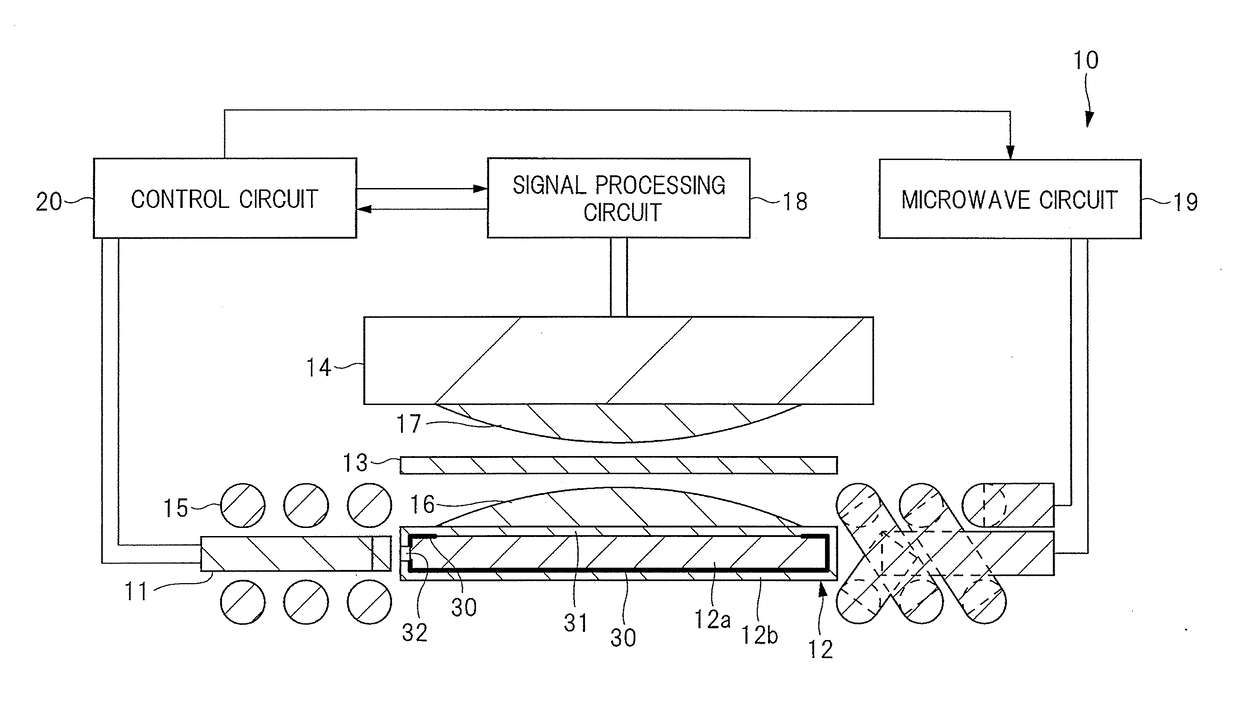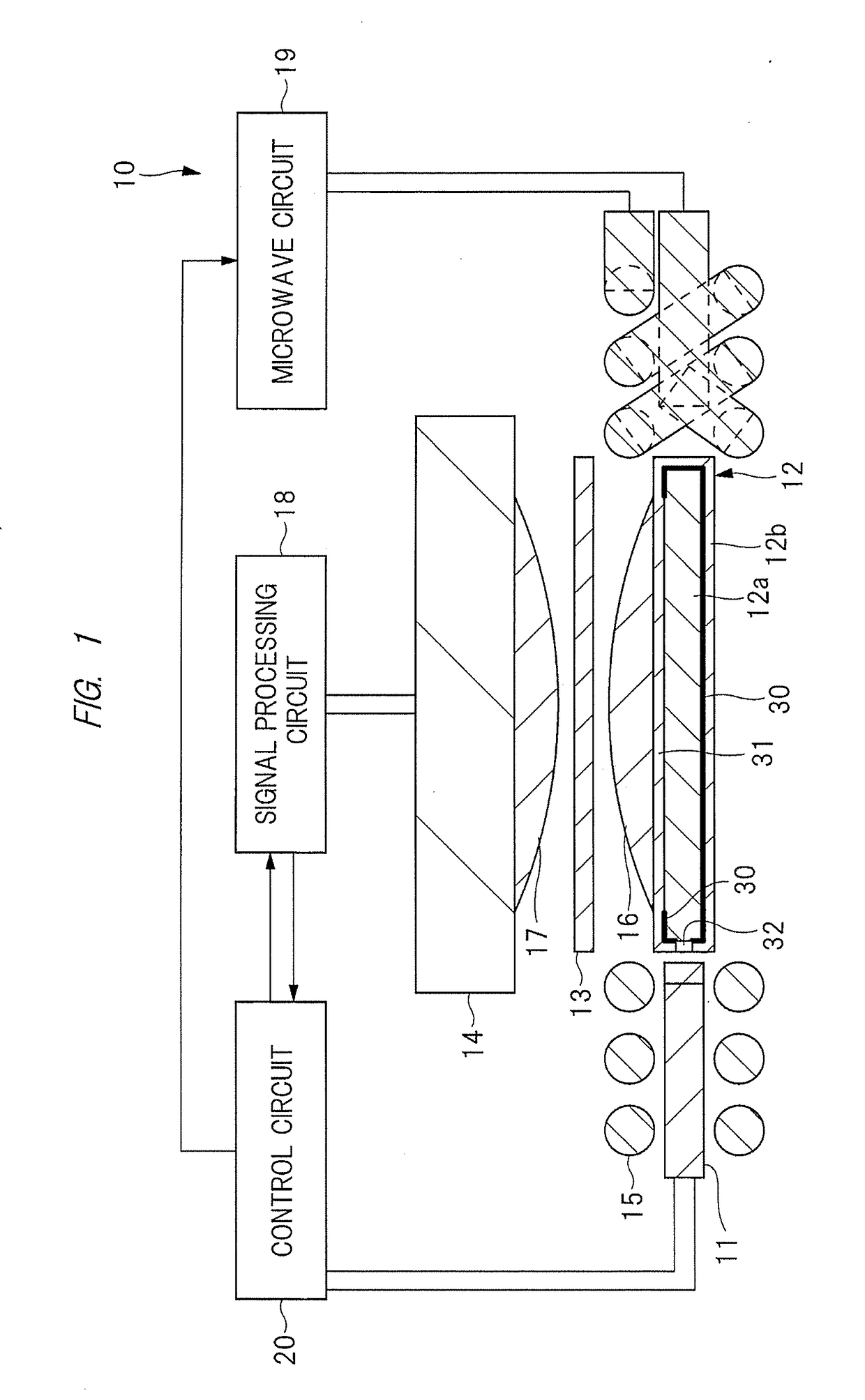Magnetometer
a magnetometer and refraction technology, applied in the field of magnetometers, can solve the problems of increasing the size of various kinds of devices formed
- Summary
- Abstract
- Description
- Claims
- Application Information
AI Technical Summary
Benefits of technology
Problems solved by technology
Method used
Image
Examples
first embodiment
[0057]FIG. 1 is an explanatory drawing showing an example of a structure of a magnetometer according to a first embodiment. FIG. 2 is a plan view of a diamond sensor unit and a microwave coil included in the magnetometer shown in FIG. 1.
[0058]A magnetometer 10 has a module package structure, and the magnetometer 10 is made thinner and smaller. As shown in FIG. 1 and FIG. 2, the magnetometer 10 includes an excitation light source 11, a diamond sensor unit 12, a low-pass filter 13, a photodiode 14, a microwave coil 15, lenses 16 and 17, a signal processing circuit 18, a microwave circuit 19, and a control circuit 20.
[0059]The lens 16 which is a first lens is provided on the diamond sensor unit 12. More specifically, the lens 16 is provided on a fluorescence output window 31 formed in a diamond sensor case 12b described later.
[0060]The low-pass filter 13 is provided above the lens 16 at a certain distance from the lens 16. The photodiode 14 which is a fluorescence intensity detecting u...
second embodiment
[0120]In the structure according to the first embodiment described above, excitation light is incident from a side surface of the diamond sensor case 12b. Meanwhile, a technique for allowing excitation light to be incident obliquely from above the diamond sensor case 12b will be described in the second embodiment.
[0121]FIG. 6 is an explanatory drawing showing an example of across section of the magnetometer 10 according to the second embodiment. FIG. 7 is a plan view of FIG. 6. Note that the signal processing circuit 18, the microwave circuit 19, and the control circuit 20 are omitted for simplification in FIG. 6 and FIG. 7.
[0122]A difference between the magnetometer 10 shown in FIG. 6 and the magnetometer 10 in FIG. 1 according to the first embodiment described above lies in that excitation light from the excitation light source 11 is not incident on a side surface of the diamond sensor case 12b, but incident obliquely from above a back surface of the diamond sensor case 12b, which...
third embodiment
[0135]The magnetometer 10 according to the first embodiment described above has a structure in which one lens is provided for one diamond sensor unit 12. Meanwhile, a case in which a plurality of lenses are provided for one diamond sensor unit 12 will be described in the third embodiment.
[0136]FIG. 8 is an explanatory drawing showing an example of a cross section of the magnetometer 10 according to the third embodiment. FIG. 9 is a plan view of FIG. 8. FIG. 9 is a plan view of the magnetometer 10 viewed from a magnetism measurement surface, that is, a main surface of the diamond sensor 12a. Note that the signal processing circuit 18, the microwave circuit 19, and the control circuit 20 are omitted for simplification in FIG. 8 and FIG. 9.
[0137]A difference between the magnetometer 10 shown in FIG. 8 and FIG. 9 and the magnetometer 10 in FIG. 1 and FIG. 2 according to the above-described first embodiment lies in that each of the lenses 16 and 17 is not formed of a single lens, but is ...
PUM
 Login to View More
Login to View More Abstract
Description
Claims
Application Information
 Login to View More
Login to View More - R&D
- Intellectual Property
- Life Sciences
- Materials
- Tech Scout
- Unparalleled Data Quality
- Higher Quality Content
- 60% Fewer Hallucinations
Browse by: Latest US Patents, China's latest patents, Technical Efficacy Thesaurus, Application Domain, Technology Topic, Popular Technical Reports.
© 2025 PatSnap. All rights reserved.Legal|Privacy policy|Modern Slavery Act Transparency Statement|Sitemap|About US| Contact US: help@patsnap.com



